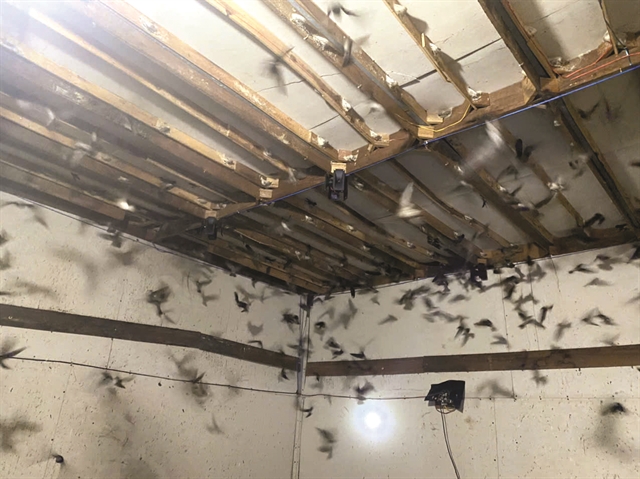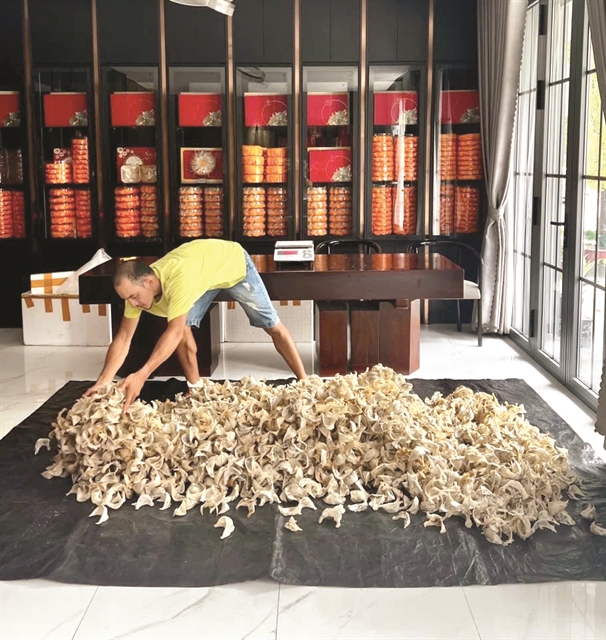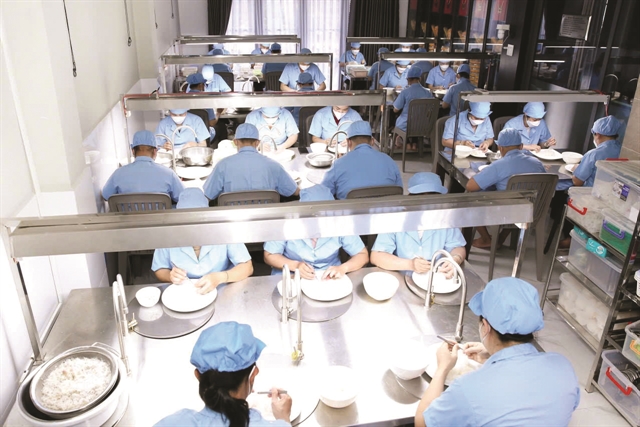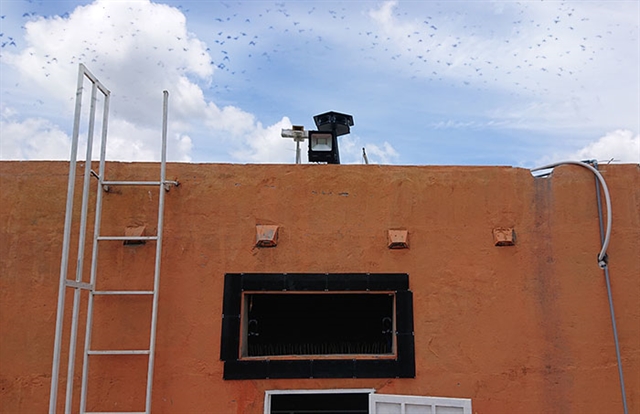 Features
Features

by Văn Châu
 |
| Inside a swiftlets' shelter in Kiên Giang Province. VNS Photo Văn Châu |
Kiên Giang Province, long known for its rice paddies and fisheries, is now emerging at the forefront of the country in the culture of swiftlets for their edible nests.
Edible bird's nests, known as yến sào in Vietnamese, are nests created from solidified saliva by swiftlets, or swallows, which are collected for human consumption.
With nearly 19 tonnes of edible nests harvested in 2024 from over 3,000 swiftlet-rearing shelters, estimated to be worth more than VNĐ450 billion (US$18.8 million), the province holds tremendous potential to turn this traditional trade into a modern, export-oriented industry.
There are opportunities in abundance — growing global demand, high price margins, and new trade agreements with China — but also significant hurdles: community backlash, lack of standards, and weak supply chain coordination.
For Kiên Giang, edible bird's nest culture is more than just a rural activity. It is a symbol of how innovation, tradition and environmental stewardship must work together.
As more families invest in building concrete houses to raise swiftlets and digital traceability, and as the province seeks to balance economic growth with social harmony, the story of bird nest farming becomes a reflection of the broader transformation sweeping through the Mekong Delta provinces.
Among the many voices behind this trade is Hoàng Đức Nhã, a farmer from Rạch Giá, who manages eight swiftlet houses under her family-run business, Du Long Farm.
 |
| A farmer in Hà Tiên checks newly harvested bird nests. VNS Photo Văn Châu |
She gestures proudly toward the tall grey structures that line her backyard. “We own eight swiftlet houses and produce around 20 kilograms of raw bird nests every month,” she says.
“Harvests have dropped by nearly 30 per cent in the last two years,” she says, her tone shifting. “There are too many swiftlet farms now. The insects the birds feed on are disappearing.”
To maintain production, Nhã ensures careful hygiene and minimises disturbance. “We let the birds come and go freely, but keeping them close means protecting their food source,” she says.
Despite the challenges, she’s still motivated. “Raw edible bird's nests fetch around VNĐ17 million ($700) per kilogram; processed nests go up to VNĐ25 million or even VNĐ30 million (roughly $1,000–1,200). It's still worth it — if you’re careful.”
Her daughter, who recently graduated from Cần Thơ University, is helping the family digitise records and apply for grants.
“We want to join a cooperative. Maybe even open a shop in the city,” Nhã adds.
Global opportunity, local tensions
A breakthrough came when the Việt Nam-China trade agreements officially allowed Vietnamese businesses to export edible bird's nests to China.
This move helped transform the industry from informal domestic sales to structured, quality-controlled export operations.
Several businesses in Kiên Giang, such as Fanza Yến Sào Co Ltd based in Hà Tiên, are preparing to take advantage.
At Fanza’s processing plant, Đặng Thanh Thiên Hậu, the company’s director, outlines the meticulous steps taken for export readiness.
“We follow GMP, HACCP and FDA standards. Edible bird's nests are sterilised at 74 degrees Celsius, sorted by colour and fibre density, and vacuum-packed,” he says.
 |
| Staff at Fanza Yến Sào Co Ltd clean and sort edible bird's nests for export to the US and China. VNS Photo Văn Châu |
In 2024, Fanza shipped over 60 kilograms directly to the United States, and 1.5 tonnes through intermediaries.
“But China will be a game-changer,” he adds. “Traceability, origin codes and sanitation certificates are mandatory there. It’s not enough to have bird nests — you need systems. You need trust.”
Fanza has begun coordinating with veterinary authorities to conduct disease surveillance, including avian flu and Newcastle testing, in anticipation of China’s import protocols.
“Most swiftlet farming remains spontaneous,” Hậu notes. “Without proper planning and branding, many farmers lose out on higher-value markets.”
Still, he remains optimistic. “Kiên Giang has the capacity to become a national hub — but we need to move as a coordinated industry, not isolated farms.”
But not everyone in Rạch Giá views the industry with such optimism. In residential neighbourhoods, complaints are growing louder — quite literally.
 |
| Loudspeakers installed on a swiftlet shelter broadcast bird calls at dawn. VNS Photo Văn Châu |
“I wake up at 4 am — not because of work, but because of those machines,” says Nguyễn Quốc Bình, who lives next to three swiftlet houses.
“They play the same bird calls over and over again. My children can’t sleep. We’ve asked for changes, but nothing happens.”
The recordings, used to lure swiftlets, are typically played from loudspeakers mounted high on the buildings.
Residents like Bình say they disrupt people's daily life, and cause community resentment.
His experience reflects a growing tension between economic benefit and social harmony.
In late 2024, provincial authorities responded by issuing a zoning plan that bans new swiftlet houses from being built in residential areas and encourages existing ones to relocate with incentives like land access and partial subsidies.
“We want the industry to grow, but it must grow responsibly,” says a representative from the Department of Agriculture. “Swiftlets should fly in peaceful skies, and our people should sleep peacefully too.”
A future built on cooperation
Environmental concerns add another layer of urgency. As more swiftlets are drawn inland, away from their natural feeding grounds, experts warn of ecological imbalance.
Without wild insects, birds may fail to thrive — reducing productivity and increasing migration. Some farmers have experimented with artificial feeding, but long-term sustainability remains in question.
Meanwhile, the lack of coordinated supply chains and processing facilities has created bottlenecks.
Many edible bird's nests are sold raw and unlabelled, leading to inconsistent quality and missed export opportunities.
Smaller farmers, like Nhã, often find themselves excluded from the most profitable markets.
“We do the work,” she says, “but without equipment or certificates, we can’t reach international buyers. The big companies get the contracts, while small farms stay local.”
Still, momentum for change is growing. Plans are underway to launch an annual Yến Sào Kiên Giang Fair, providing a platform for farmers, processors and buyers.
A pilot traceability project using QR codes is being tested in Hà Tiên. Local banks are offering low-interest loans for equipment upgrades, and training sessions on hygiene and grading are scheduled throughout the summer.
Yet for many farmers and entrepreneurs, these steps, while encouraging, are not enough.
What they need is not just support in moments of difficulty, but long-term policy commitment that considers edible-nest bird farming as a central part of rural development.
In conversations with both producers and processors, one recurring concern is the lack of specialised guidelines tailored to swiftlet farming.
While protocols exist for poultry and aquaculture, swiftlets — part wild, part domestic — remain in a regulatory grey zone.
This gap complicates efforts to meet the veterinary and food safety standards required by importing countries.
The path to official registration is also described by many as confusing and overly burdensome.
Farmers often navigate a maze of documents and procedures just to legalise the existence of their swiftlet houses or apply for basic hygiene certification.
Some have simply given up, choosing instead to operate informally, which limits access to export channels and investment support.
“We need local help — people on the ground who understand this industry,” says Nhã. “We don’t have time to go back and forth to Rạch Giá City for every signature.”
 |
| Edible bird's nests are packaged luxuriously to serve domestic and foreign markets. VNS Photo Văn Châu |
Processing remains another bottleneck. In rural communes far from Hà Tiên or Rạch Giá, swiftlet farmers lack access to clean water supply, proper wastewater treatment or reliable electricity supply.
Most edible bird's nests are still cleaned by hand, often on bamboo trays in open-air spaces.
While this artisanal approach has charm, it cannot guarantee the microbiological safety levels demanded by high-end markets.
Several farmers have expressed hope that the province might eventually invest in shared facilities — modern centres where bird nests can be cleaned, graded and packaged according to export standards.
Education is also lacking. Outside of a few towns, knowledge of the bird life, disease prevention and humidity control remains patchy.
While some wealthier farms can afford private consultants, many rely on neighbours or online videos.
In response to these layered challenges, the provincial government is drafting a five-year plan that seeks to redefine how Kiên Giang supports its edible bird’s nest industry.
The plan includes proposals to build regional processing hubs, expand mobile veterinary services, simplify digital registration, and subsidise modern acoustic and ventilation equipment.
While still under discussion, the programme reflects a growing consensus that swiftlet farming is not just a niche activity — it is a strategic economic sector with the potential to lift hundreds of rural households out of poverty.
“We must treat it with the seriousness it deserves,” says a representative from the Department of Agriculture and Rural Development. “It’s no longer just a bird in the sky — it’s a bridge between tradition and modern agriculture.”
Experts believe that with proper support, Kiên Giang could triple its export revenue from edible bird's nests by 2030, create thousands of rural jobs, and position itself as Southeast Asia’s leading producer.
Back at Du Long Farm, as dusk settles over Rạch Giá, the sky darkens with returning birds.
They dart and dive between rooftops before disappearing into the quiet of their shelters.
“We don’t own the birds,” Nhã smiles. “They choose to come back.”
It is a quiet truth that carries across the province. In a world of noise and competition, Kiên Giang’s edible bird's nest farmers remind us that growth can still happen gently — with patience, respect for nature, and a little trust in the wind. VNS




